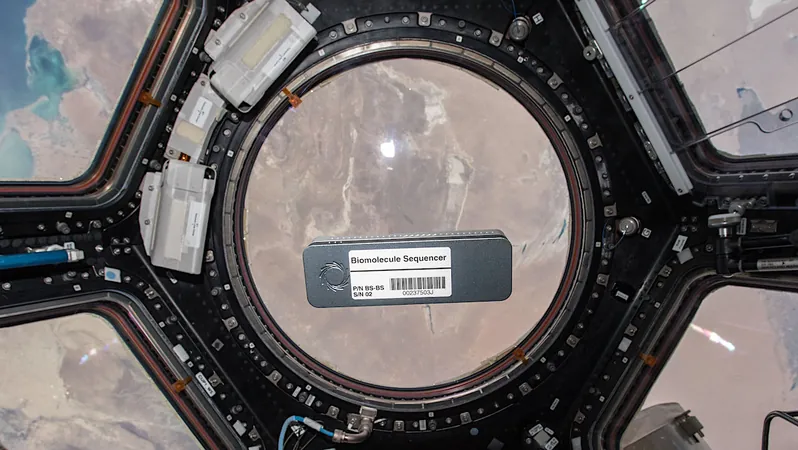
Unlocking the Future of Space Exploration with Nanopore Sequencing Technologies: Essential Techniques and Insights
2025-03-24
Author: Daniel
Introduction
As humanity sets its sights on the ambition of interstellar exploration, the quest to identify and understand extraterrestrial life forms has never been more urgent. The key to this endeavor lies in our ability to analyze and interpret the metabolic and genomic systems of any life we may encounter. Understanding the biological structures that differentiate alien organisms from life on Earth could not only deepen our comprehension of biology itself but could also shine a light on the evolution of life across the cosmos.
Advancements in In Situ Analysis
While sending samples back to Earth remains a significant logistical challenge, advancements in in situ (on-site) analysis are paving the way for unprecedented real-time scientific discoveries. Imagine astronauts or robotic missions equipped with sophisticated tools that can analyze samples right where they are found, sending vital information back to Earth at the speed of light. This leap in capability means researchers can refine their methods and knowledge dynamically, transforming our approach to exploring other planets and moons.
The Role of Nanopore Sequencing
At the heart of modern genomic analysis is nucleic acid sequencing, a process that deciphers the sequences of DNA and RNA – essential information for understanding genomes and transcriptomes. Among various sequencing technologies, nanopore sequencing stands out with its unique advantages: it’s capable of processing long strands of nucleic acids in real-time and can be deployed in portable configurations. This flexibility allows scientists to conduct rapid analyses in the most diverse and remote environments.
The MinION Sequencer
Let’s consider the portable MinION sequencer, a groundbreaking device that utilizes a flow cell with 512 channels, each containing four nanopores. This results in a staggering 2,048 nanopores available for sequencing DNA or RNA. The technology works by allowing a motor protein to guide nucleic acids through a nanopore, effectively measuring ion flow disruptions that occur as these molecules pass through, producing a unique electrical signature or 'squiggle' that represents the genetic information.
Challenges and Solutions
Nanopore technology has evolved significantly over the last decade, yet it continues to face challenges in terms of protocol standardization and technological refinement. This multi-disciplinary article emphasizes overcoming those hurdles, seeking to enhance our understanding and maximize the data retrieved from nanopore systems for both terrestrial and extraterrestrial applications.
NASA's Innovations
Furthermore, NASA has already begun employing these innovations on the International Space Station. Former astronaut Peggy Whitson and her team worked on the Genes In Space-3 experiment, showcasing how portable DNA sequencing can monitor crew health in microgravity. This practical application signifies a future where real-time health assessments could become a norm during long-duration space missions.
Maximizing Nanopore Sequencing
To make the most of nanopore sequencing, this article offers robust guidelines, tips, and tricks based on statistical analyses and experimental results. By unlocking the full potential of this technology, scientists can push the boundaries of our knowledge about life, enrich our understanding of genetics, and potentially identify new forms of life beyond Earth.
Conclusion
As we embark on our quest for cosmic discovery, mastering techniques like nanopore sequencing will be crucial – not just for exploration, but for expanding our understanding of biology on a universal scale. Stay tuned for more insights and advancements that could revolutionize our future in space.




 Brasil (PT)
Brasil (PT)
 Canada (EN)
Canada (EN)
 Chile (ES)
Chile (ES)
 Česko (CS)
Česko (CS)
 대한민국 (KO)
대한민국 (KO)
 España (ES)
España (ES)
 France (FR)
France (FR)
 Hong Kong (EN)
Hong Kong (EN)
 Italia (IT)
Italia (IT)
 日本 (JA)
日本 (JA)
 Magyarország (HU)
Magyarország (HU)
 Norge (NO)
Norge (NO)
 Polska (PL)
Polska (PL)
 Schweiz (DE)
Schweiz (DE)
 Singapore (EN)
Singapore (EN)
 Sverige (SV)
Sverige (SV)
 Suomi (FI)
Suomi (FI)
 Türkiye (TR)
Türkiye (TR)
 الإمارات العربية المتحدة (AR)
الإمارات العربية المتحدة (AR)